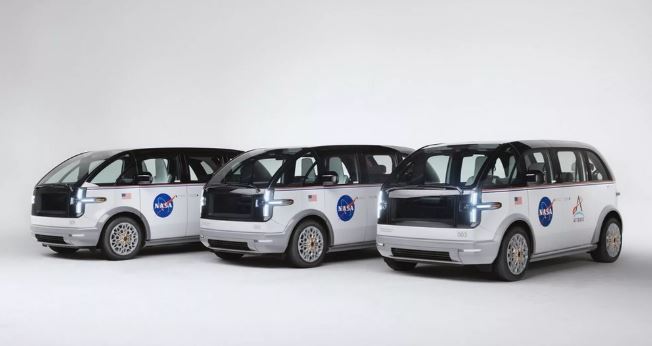NASA’s Artemis program is a visionary initiative aimed at returning humans to the Moon and establishing a sustainable presence there. The program builds upon the groundbreaking achievements of the Apollo missions in the 1960s and 1970s, which saw humans set foot on the lunar surface for the first time. With Artemis, NASA seeks to leverage advancements in technology, international collaborations, and commercial partnerships to enable crewed missions to the Moon and pave the way for future deep space exploration, including human missions to Mars.
In pursuit of its ambitious goals, NASA has been actively working on enhancing crew transportation capabilities. The recent delivery of three Canoo electric vehicles represents a significant milestone in this endeavor. Canoo, an American electric vehicle manufacturer, was selected by NASA in 2022 to design and supply specialized vans known as Crew Transportation Vehicles (CTVs) for the Artemis program.
The collaboration between NASA and Canoo focused on meeting the specific requirements of crew transportation. An essential consideration was the interior volume of the vehicles, ensuring sufficient space to accommodate astronauts wearing their Orion crew survival system spacesuits. This meticulous attention to detail ensures the safety and comfort of the astronauts during their journey from their living quarters to the launch pad.
Each Canoo CTV has been purpose-built to transport four astronauts, along with necessary support personnel such as a spacesuit technician. Moreover, the vehicles are equipped with specialized equipment required for the journey to Launch Pad 39B on the day of the launch. The joint effort between Canoo and NASA underscores their shared commitment to prioritize the well-being of the crew as they embark on their lunar missions.

The collaboration extended beyond functional considerations to encompass aesthetic design aspects of the CTVs as well. Representatives from NASA’s Astronaut Office played an integral role in selecting interior and exterior markings, colors, and even wheel well designs, ensuring a visually appealing and cohesive look that aligns with NASA’s high standards.
The introduction of the Canoo CTVs marks the retirement of the Astrovans, which have been in service since 1984. These modified Airstream motorhomes have faithfully served as crew transportation vehicles for several decades, supporting numerous space missions. However, the decision to transition to the Canoo CTVs reflects NASA’s commitment to leveraging advancements in technology, efficiency, and environmental sustainability.
Tony Aquila, the CEO of Canoo, expressed great enthusiasm for being part of the Artemis program and delivering zero-emission crew transportation vehicles designed specifically for these critical missions. Aquila highlighted the immense pride felt by Canoo and its partners in contributing to the transportation of astronauts for the initial nine miles of every launch, a significant part of their journey towards the Moon.
Initially, the Canoo CTVs will be utilized for astronaut training exercises at the Kennedy Space Center in Florida, allowing the astronauts to become familiar with the vehicles and their features. This preparation phase is crucial for ensuring smooth operations during the upcoming missions. In November 2024, the Canoo CTVs will play a pivotal role in the Artemis II mission, ferrying astronauts on the final leg of their journey before departing Earth. This 10-day flight, which will take the crew around the Moon and back, holds tremendous significance as a stepping stone toward NASA’s overarching goal of establishing a sustained human presence on our celestial neighbor and unlocking the secrets of the universe.
